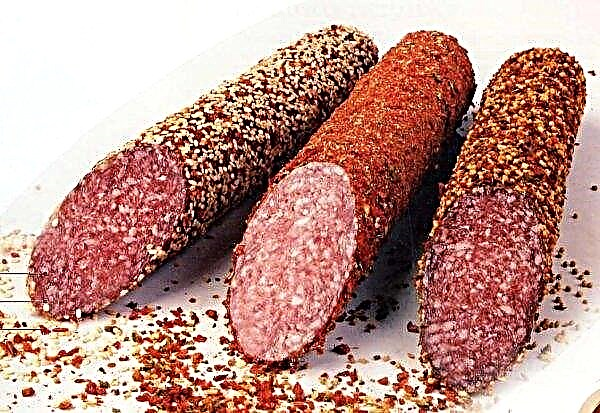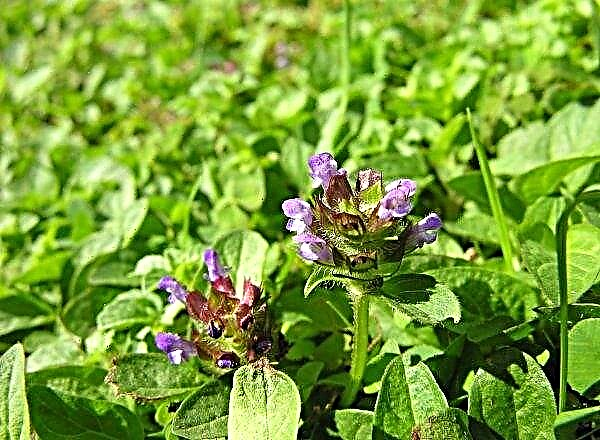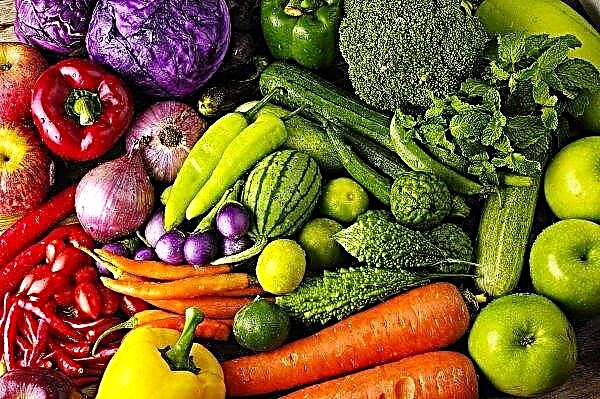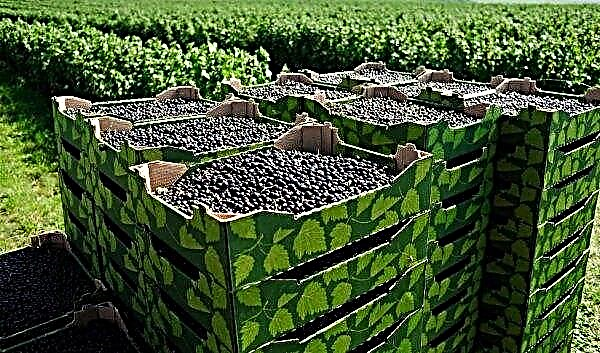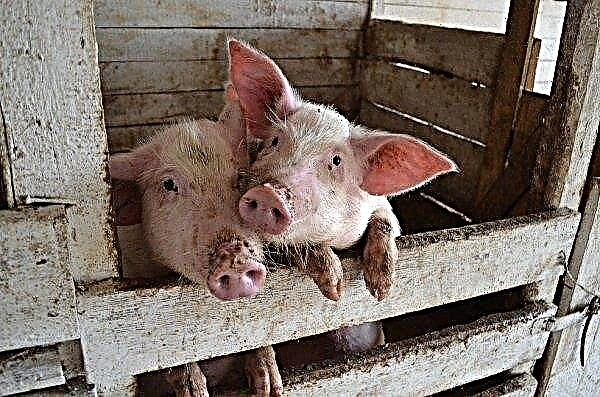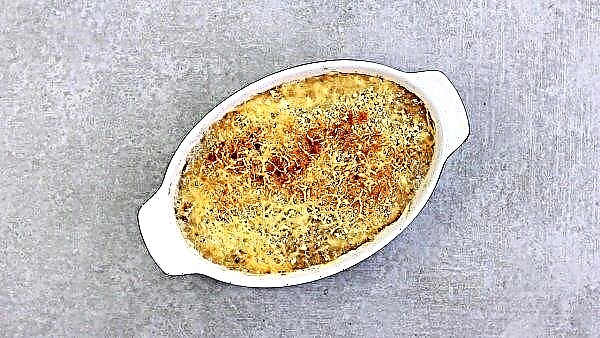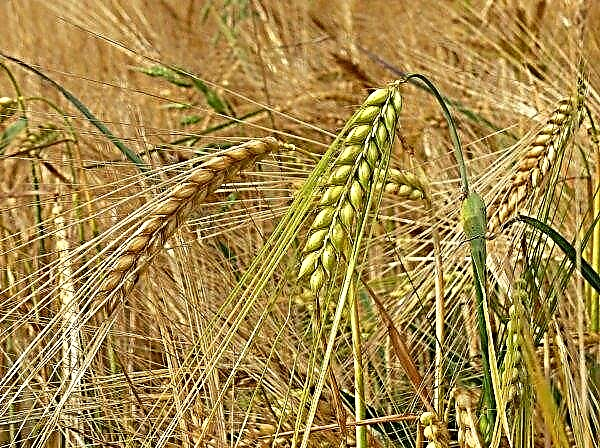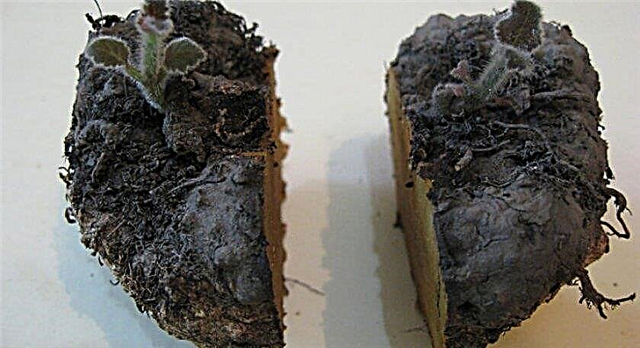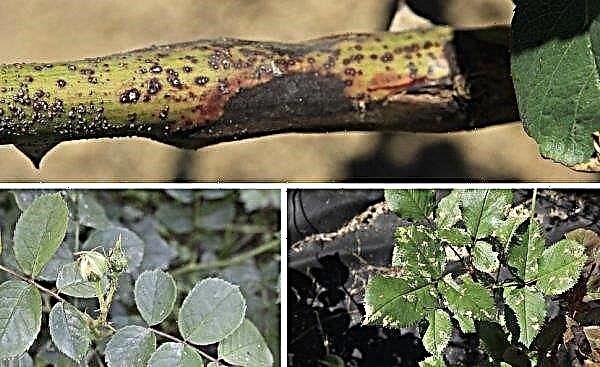Cabbage is grown in almost all suburban areas, since this vegetable is well stored in the winter, contains many vitamins and can be used to prepare a variety of dishes. One of the popular varieties of this vegetable is Zimovka cabbage 1474, which is popularly called simply Zimovka. This article presents the characteristics of the variety, its advantages and disadvantages, and also lists the rules for growing seedlings, caring for plants and eliminating possible diseases and pests.
Description and characteristic
Zimovka cabbage variety 1474 was obtained in the 60s of the twentieth century by scientists of the All-Union Scientific Research Institute of Selection and Seed Production. Experimenting with samples of cabbage of foreign varieties, breeders wanted to get a new species that would be distinguished by the large size of the fruits and their good keeping quality, and could be grown in regions with any climate. Officially, a new variety was registered in 1963.
Did you know? The famous ancient Greek mathematician and philosopher Pythagoras was engaged in the selection of cabbage and highly appreciated the useful qualities of this vegetable.
Variety characteristics are presented below:
- Variety Zimovka belongs to late ripening, it takes 140-160 days to ripen the crop.
- The head of cabbage is dense, has a rounded and slightly flattened shape. It consists of thin gray-green rounded leaf plates and can reach a diameter of 70–120 cm.
- The leaves of the vegetable are medium in size and wavy, covered with a layer of wax coating. On the cut, they are painted in yellow and white. The length of the sheet is 40–48 cm, and the width is from 32 cm to 45 cm.
- The head of cabbage has a long outer stump. The cabbage leaves taste sweet and their veins are soft. During the first 2-3 months after harvesting, the leaves have a slight bitter taste, which disappears with longer storage.
- Productivity from 1 m² is 6-7 kg. The weight of one fetus is 2-3.5 kg.
- Vegetables have a good shelf life and can be stored up to 8 months after harvest.
- Zimovka cabbage is characterized by frost resistance, drought resistance and unpretentious to the nutrient composition of the soil.

Pros and cons of cabbage varieties Zimovka
Cabbage Zimovka quickly gained popularity among gardeners due to its many positive characteristics.
- The advantages of the variety include the following:
- high productivity;
- excellent presentation of fruits;
- good storage and transportability;
- resistance to cracking of the heads;
- universal use of fruits;
- excellent taste, high content of vitamin C;
- unpretentiousness to growing conditions;
- frost resistance;
- resistant immunity to pinpoint necrosis and gray mold.
Optimal growing time
To determine the optimal seed planting period, it is necessary to take into account the climatic features of a particular region. In the northern regions, it is recommended to grow Zimovka 1474 cabbage exclusively in seedlings, and in the southern regions the seeds can be sown immediately in open soil.
Sowing seeds for seedlings is usually carried out in early April, so that you can transplant the sprouts on the site in the second half of May or in early June. If the seeds are immediately planted in open soil, the sowing dates fall at the end of May, but in the case of night frosts, beds with seeds must be covered with a film.

The rules for growing varieties
Cabbage Zimovka 1474 is unpretentious to growing conditions, and its seeds are characterized by good germination. But in order to achieve high yields, it is recommended to carry out preliminary preparation of planting material and land on the site, as well as follow simple rules for growing seedlings and transplanting them into open ground.
Seed selection and preparation
Zimovka 1474 cabbage seeds are recommended for purchase in specialized stores.
To prevent damage to plants by diseases and pests, as well as accelerate the germination of planting material, you need to perform these steps to prepare it:- select seeds of the same size and regular shape;
- soak the planting material in an aqueous solution of potassium permanganate for 15-20 minutes to disinfect, and then rinse it with clean water;
- to accelerate the germination of seeds, you can put them in cheesecloth and lower them for 15 minutes in hot water with a temperature of + 50 ° С. After this time, gauze with planting material must be cooled in cool water;
- after performing all of the above actions, the seeds must be laid out on paper with one layer and dried at room temperature.

Growing seedlings
It takes about 50 days to grow strong seedlings of cabbage Zimovka 1474, so it is recommended to start this process in early April. Seeds are planted in small containers or individual containers filled with a mixture of garden soil, humus, sand and wood ash (all ingredients are taken in equal proportions).
Important! 10-14 days before planting the seeds, the resulting soil mixture must be calcined in the oven for 20 minutes at a temperature of +200°With or spill with a hot aqueous solution of potassium permanganate for disinfection.
Step-by-step instructions for growing cabbage seedlings Zimovka:
- Pour the soil in containers with water so that it is well moistened. Make indentations about 1 cm in size at a distance of 3-4 cm from each other.
- In each recess, place 1-2 seeds of cabbage and sprinkle them with soil. Carefully level the ground with your hands.
- Cover the container with the seeds planted in film or glass. Put it in a well-lit place, periodically moistening the soil with warm water as it dries.
- Seedlings appear 5 days after planting. After this, the shelter must be removed, and the container with seedlings should be kept at a temperature of + 10 ° C until the first green leaves appear.
- 7-10 days after seed germination, seedlings are watered with a weak solution of potassium permanganate for disinfection and top dressing with nutrients.
- If the sowing of seeds was carried out in one large capacity, then 10-14 days after the emergence of seedlings, when they already have 4-5 leaves, the sprouts dive on individual containers. In this case, the roots of the shoots need to be shortened by a third of their length.
- After a dive, the seedlings should be kept in a well-lit place with an air temperature of +14 ... + 18 ° С;
- The daylight hours for cabbage seedlings should be at least 12 hours a day. If necessary, use artificial lighting sources.
- As the soil dries up, moderate watering of the sprouts is carried out with warm water. After irrigation, surface loosening of the soil is carried out.
- As an additional top dressing, you can sprinkle the leaves of seedlings with wood ash powder.
- The container with seedlings should be kept in a well-ventilated place, but sprouts should be protected from cold drafts so that seedlings do not die.

Land preparation on the site
To grow cabbage Zimovka 1474 brought a generous harvest, you need to choose the right site.
A place under the cabbage should meet the following requirements:
- good sun exposure;
- loamy or clayey soil composition;
- neutral acidity of the soil;
- the absence of groundwater close to the surface of the earth;
- good precursors for vegetables are legumes, potatoes, cucumbers and tomatoes;
- You can not plant this culture for 3 years on the site where turnip, turnip or radish were previously grown.
Did you know? The name "cabbage" comes from the ancient Greek word "caputum" and literally translates as "head".
Preparation of the site for planting cabbage seedlings begins in the fall, after harvesting.
This procedure includes the following actions:
- thorough removal of all plant debris after harvest in the fall;
- deep autumn digging of the earth with the addition of lime;
- making humus in the spring (1 bucket per 1 m²) and re-digging the site;
- digging holes 2 weeks before planting seedlings.
Transplanting seedlings into the ground
In order for cabbage seedlings to take root well in the open ground, it must get stronger at the time of transplantation. Each sprout should have 5-6 strong green leaves, and the height of the seedling should be at least 15 cm. Usually plants reach these values by the end of May or early June, after which they are planted in a permanent place.
Instructions for transplanting seedlings of cabbage Zimovka:
- Seedlings should be placed on the site according to the scheme 35 × 60 cm.
- At the bottom of each hole put 2 tbsp. l superphosphate, 2 tbsp. wood ash and 1 part urea.
- Water the sprouts in individual containers a little with water, so that it is easier to remove them with an earthen lump. Carefully remove the seedlings from the containers and place them in the prepared wells.
- Sprinkle the roots of seedlings with earth and lightly tamp the surface with your hands.
- Pour the planted seedlings abundantly with warm water.
Features of plant care
Zimovka cabbage of 1474 variety is undemanding in care, but for normal growth, plants need sufficient moisture and minimal soil care in the beds. This variety can be grown even on those soils that contain few nutrients, but to increase the yield of the crop, it is recommended to fertilize.
Watering rates
This variety can tolerate short-term drought, but reacts negatively to waterlogging of the soil.
Basic rules for watering cabbage Zimovka:Important! If you overdo it with watering the plants, their root system completely dies after 12 hours.
- during the growth period, 1–5 l of water should be consumed for each seedling;
- adult plants need about 2 buckets of water;
- the frequency of watering depends on weather conditions and is 1-2 times a week. Plants are watered after the topsoil has dried;
- you need to irrigate the cabbage with standing warm water with a temperature of +18 ... + 23 ° С;
- It is recommended to use the drip method of watering with a watering can;
- 3-4 weeks before harvesting, watering the cabbage should be stopped so that the cabbages do not crack and are better stored in the winter.

Top dressing
The introduction of nutrients during the active growth of plants helps to significantly increase the yield of this crop.
It is best to feed the wintering cabbage as follows:
- the first fertilizer is applied 20 days after the seedlings are planted on the site - they are watered with an aqueous mullein solution (1 part of the product in 4 parts of water), spending 1 liter of fertilizer for each plant;
- repeated fertilizing is carried out 10 days after the first feeding - 1 liter of an aqueous solution of chicken droppings (1 part of the droppings to 4 parts of water) is applied to each plant;
- after another 10 days, the cabbage is again watered with a solution of mullein or bird droppings, spending about 6-8 liters of agent per 1 m²;
- to prevent the occurrence of pests and additional nutrition, you can sprinkle cabbage leaves with wood ash every 10 days.
In order for root dressings to be better absorbed, they are recommended to be applied along with watering cabbage.
Did you know? Fresh cabbage juice has a rejuvenating effect, and also contributes to disinfection and healing of wounds.
Soil cultivation and weeding
Weeds are able to quickly drown out the growing seedlings, so as they appear, the soil around the plant is weeded. Removed weed grass must be removed from the site to prevent pests and diseases.
Surface loosening of the soil is carried out simultaneously with weeding the soil and after each irrigation. The procedure is carried out carefully so as not to damage the root system of cabbage. The loose soil promotes good air access to the roots of the plant and prevents stagnation of water in the soil.

Pests and diseases
When all of the above care recommendations are followed, Zimovka cabbage is practically not affected by diseases and harmful insects.
But sometimes plants can be threatened by such infections:
- Blackleg. The causative agent of the disease is a fungus, which is located in the upper layer of soil. It quickly multiplies in waterlogged soil and provokes decay of the root neck - it becomes dark and deformed, and the affected plant dies. Sick plants should be immediately removed from the site and burned, and the beds should be watered with a solution of potassium permanganate.

- Kila. This disease also refers to fungal and is manifested by the appearance of growths on the root system of cabbage. At the same time, the roots cannot absorb moisture and nutrients from the soil that the plant needs to grow. As a result, the land part of the cabbage is poorly developed and in the future the plant dies. Infected specimens are removed from the site along with a lump of earth formed around the roots. The hole remaining after removal of the plant is abundantly sprinkled with lime.
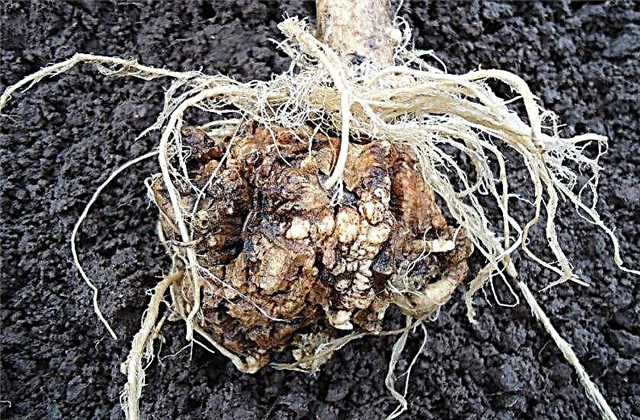
- Mucosal bacteriosis (wet bacterial rot). The disease has a bacterial nature and leads to decay of the head of cabbage. Covering leaves begin to blacken, become damp, and exhale an unpleasant odor. In the future, this process goes to the rest of the leaves and the cabbage completely rots. Affected heads of cabbage need to be removed from the site, and the beds should be treated with chemical preparations (for example, Trichodermin).

- Downy mildew (peronosporosis). The source of this infection is a fungus. On the outside of the leaves of the vegetable appear yellowish spots of irregular shape, the lower surface of which is covered with a grayish-white coating. The spots gradually increase in size, leading to yellowing and complete death of the ground part of the plant. The affected parts of the cabbage are cut and burned, and the beds are treated with chemical preparations (for example, Oksikhom).

- Cabbage fly. The insect lays eggs in the upper soil layer, and the appeared larvae destroy the root system and the stalk of the vegetable. The plant begins to noticeably lag behind in growth, and with a severe defeat the head of cabbage deteriorates from the inside and becomes unsuitable for storage. You can scare away the pest from the beds by sprinkling the aisles with a mixture of tobacco and lime. Of the chemicals you can use "Bazudin."

- Slug. These pests are thick caterpillars eating cabbage leaves. In this case, round through holes are noticeable on the head, and the surface of the leaves is covered with sticky mucus. Affected cabbage leaves turn yellow and die. With a small number of pests, they are collected manually, and the aisles are sprinkled with sawdust - slugs cannot move on them - or with ground red pepper. Of the chemicals used 0.5% solution of copper sulfate or the drug "Meta".
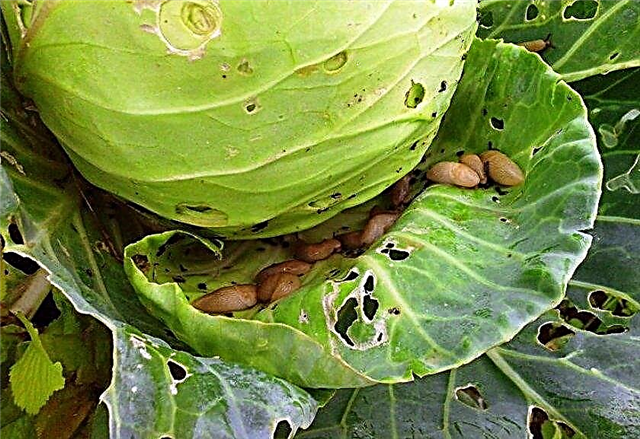
- Belianka (cabbage butterfly). This white butterfly lays eggs among the leaves of cabbage. From the eggs appear larvae that destroy the head of cabbage from the inside, eating its juicy flesh. A sign of the appearance of a whitefish is gnawed leaves of a vegetable. To combat the pest, the beds are sprayed with an aqueous solution of laundry soap, and in case of severe damage, chemicals are used (for example, Inta-Vir).
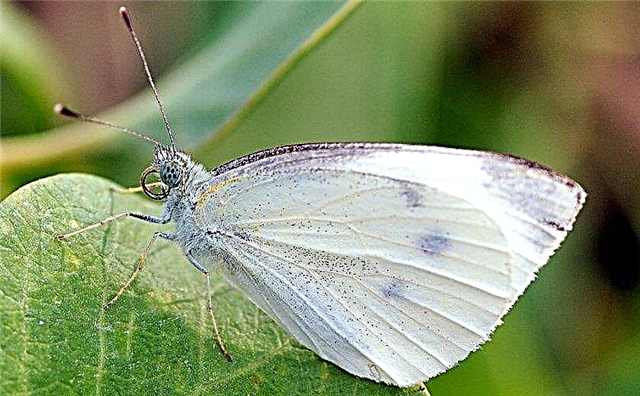
- Aphid. These small green insects and their larvae feed on the juice of cabbage leaves. As a result of their appearance, the leaves turn yellow or pink, and their edges curl and dry out. Cabbage becomes loose and gradually disappears.At the initial stage, you can get rid of the pest by spraying the beds with a solution of garlic or tobacco. With a significant lesion against aphids, insecticides are used (Iskra-M, Senpai).

- cultivate the soil and cabbage seeds before planting;
- observe the correct watering regime;
- remove plant debris from the soil;
- carry out autumn digging of the soil;
- observe crop rotation;
- adhere to the recommended scheme for planting cabbage;
- periodically inspect plants for signs of disease or pest damage.
Harvesting and storage rules
Heads of cabbage of this variety ripen in late September or early October. The fruits are resistant to frost, but before the onset of severe colds and the rainy season, it is recommended to remove them from the garden so that the vegetables do not rot.
Important! Cabbage Zimovka 1474 can withstand frosts to -6 ° C, while maintaining its good taste and attractive presentation.
Basic rules for harvesting and storage of cabbage Zimovka:
- heads of cabbage need to be dug in dry weather so that the leaves are dry and do not rot;
- harvesting is carried out carefully so as not to damage the fruits;
- the head of cabbage is removed from the soil along with the root and cleaned of the upper leaves;
- after digging up the cabbage should be removed from the sun and hung in the shade to dry;
- the room in which the vegetables are dried should be well ventilated;
- fruit storage is carried out in a darkened cellar with good ventilation and an air temperature of about 0 ... + 2 ° C;
- only whole heads of cabbage are suitable for winter storage without mechanical damage and rot;
- vegetables can be stacked on shelves, hung from the ceiling or stacked in small containers, pouring each layer of fruit with chalk. Top containers are covered with a layer of dry straw.

If you follow the above recommendations, then Zimovka cabbage tolerates long-term winter storage.
The taste of the vegetable does not deteriorate, so it is used for cooking:
- first courses (cabbage, borsch, soups);
- vegetable side dishes and stews;
- toppings for baking;
- fresh salads;
- pickled appetizers and pickles.














